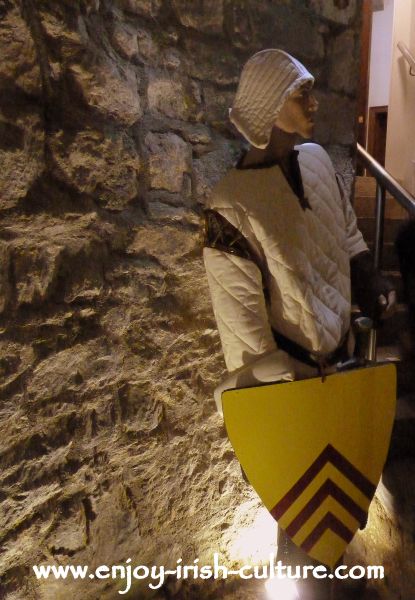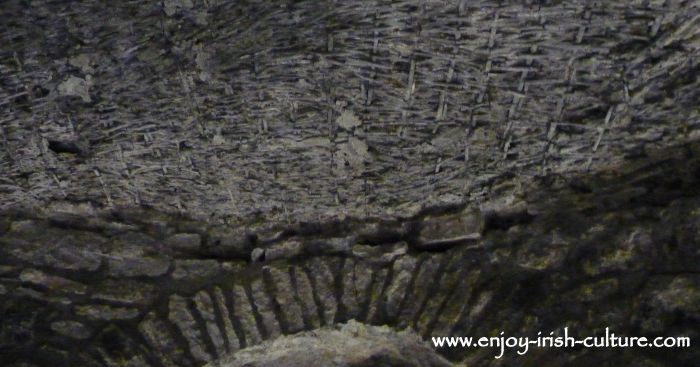Kilkenny Castle-
The Early Phase
Kilkenny Castle is one of the prime tourist spots in Ireland and is in the care of the OPW (Office of Public Works.) Because the castle remained a family residence for some six hundred years, it underwent many architectural changes over the centuries. The castle was lovingly restored by their architects and master craftsmen who chose to restore it as it would have looked in the 1830ies. Little remains today of the early medieval castle that I want to focus on on this page.
Kilkenny Castle and the river Nore.
History Of The Early Castle
Kilkenny Castle is one of the earliest Norman stone castles to be built in Ireland.
It was built by William Marshall (c. 1146-1219) starting in 1195 and completed around 1210. William Marshal was the 4th Earl of Pembroke and by marrying Isabel De Clare became son in law to Richard De Clare also known as Strongbow, the man credited with initiating the Norman invasion of Ireland.
The location of the castle was perfectly chosen, on a high plateau overlooking a fording point in the river Nore. It was not the first fortification here. Previously, this spot was the seat of the Gaelic kings of the area and most likely there was a stone fort or a ring fort in place at this location before the Normans built their first motte and bailey.
Facts About The Early Castle
- Instead
of actual windows which are a later addition to the castle, the medieval
castle featured arrow loops. See them on the photo above. arrow
loops were designed for defensive purposes- for shooting arrows through
them. The few remaining arrow loops at the castle will show you just how
thick the walls really are.
- Arrow
loops feature granite keystones. Granite of course is a very hard and
enduring rock which supports the softer limestone structure.
- Recent
excavations on the site revealed a timber structure which preceded the
stone castle. Archaeologists now believe that Kilkenny Castle itself might
have been the original Strongbow fortification. Strongbow and a band of
knights were present at Kilkenny.
- In
1307 the first images of the castle were recorded showing it as a
‘keepless castle’ consisting of four towers, surrounded by a moat which
encircled various other buildings including a chapel and a great hall. The
original castle was a military stronghold, and designed with strong
defences. Three of the original four towers survive.
- The
North West Tower has the oldest rooms still in existence in the castle
today, dating back to the 13th century.

Norman knight guiarding the stairs at Kilkenny Castle
- The
early castle was strongly defensive. Instead of windows as we know them
there were arrow loops in the thick castle walls.
- There
was a moat and a double, in parts treble, curtain wall. The Medieval
castle had an outer and an inner courtyard, similar to Cahir
Castle, with the inner courtyard providing an added later of
safety for the residents.
- To
illustrate the importance of Kilkenny castle, kings stayed here including
King Richard II of England who came for a month in 1395.
- Excavations
at the tower found a medieval sallyport here, dating to the times
of medieval siege warfare. A sallyport was a facility for the besieged to
launch surprise attacks from on any potential attackers of the castle,
without compromising the security of the castle itself. These surprise
attacks on the enemy were called ‘sallies’.
- The
castle had a very steep batter wall, a sloping foundation aiding in the
defence
of the castle during medieval siege warfare.

- The
wattle and daub ceiling on the photo above in the North West tower’s
oldest room is medieval. The builders used willow branches for the
framework. The original function of this structure was not as wall plaster
as you might think. Instead, it was part of a wooden support structure
that enabled the builders to erect a
vaulted structure on top.
More About Medieval Irish Castles
Fascinating Castle History
- The
castle had a defensive moat also, which was filled up during the 17th
century.
- The
castle’s walls were built of limestone which was quarried nearby.
- More About Kilkenny Castle: Find out about changes made to the castle during the 600 years of serving as a butler family residence and find tourist information about the castle including our special tips and opinion.
We hope you enjoyed this article.
How about telling your friends about our website so that they, too may find and read our content?
You can use the easy-to-use social functions we provide at the top left and bottom. Thanks so much!
Warmest regards from Susanna and Colm!
Return to the top of this page
Return to 'Irish Castles'.
We invest a lot of our own funds and free time into this website so that you can find out about Irish culture, heritage and history.
Please return the favour and help us cover our cost by clicking on Google ads and/ or buying us a cup of coffee! Thank you so much in advance.
Warmest regards, Colm & Susanna
|
|
|
|
Enjoy this page? Please pay it forward. Here's how...
Would you prefer to share this page with others by linking to it?
- Click on the HTML link code below.
- Copy and paste it, adding a note of your own, into your blog, a Web page, forums, a blog comment,
your Facebook account, or anywhere that someone would find this page valuable.
|
|
|
|
- Home
Customs and Traditions
Travel
Music
Heritage
About This Website